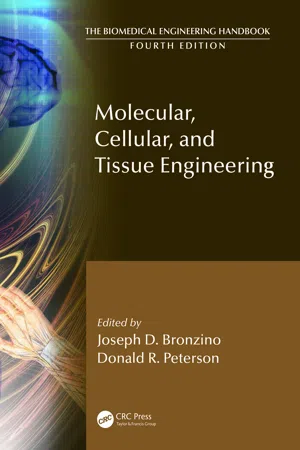
- 1,891 pages
- English
- PDF
- Available on iOS & Android
Molecular, Cellular, and Tissue Engineering
About This Book
Known as the bible of biomedical engineering, The Biomedical Engineering Handbook, Fourth Edition, sets the standard against which all other references of this nature are measured. As such, it has served as a major resource for both skilled professionals and novices to biomedical engineering.
Molecular, Cellular, and Tissue Engineering, the fourth volume of the handbook, presents material from respected scientists with diverse backgrounds in molecular biology, transport phenomena, physiological modeling, tissue engineering, stem cells, drug delivery systems, artificial organs, and personalized medicine.
More than three dozen specific topics are examined, including DNA vaccines, biomimetic systems, cardiovascular dynamics, biomaterial scaffolds, cell mechanobiology, synthetic biomaterials, pluripotent stem cells, hematopoietic stem cells, mesenchymal stem cells, nanobiomaterials for tissue engineering, biomedical imaging of engineered tissues, gene therapy, noninvasive targeted protein and peptide drug delivery, cardiac valve prostheses, blood substitutes, artificial skin, molecular diagnostics in personalized medicine, and bioethics.
Frequently asked questions
Information

Table of contents
- Front Cover
- Contents
- Preface
- Editors
- Contributors
- Chapter 1: Historical Perspective and Basics of Molecular Biology
- Chapter 2: Biomolecular Interactions
- Chapter 3: Recent Advances in DNA Separations: Plasmid Purification, Rapid Electrophoresis, and Affinity-Based Recovery
- Chapter 4: Systems and Technology Involving Bacteria
- Chapter 5: Expression in Mammalian Cells
- Chapter 6: DNA Vaccines Production and Engineering
- Chapter 7: Biomimetic Systems: Concepts, Design, and Emulation
- Chapter 8: Transport/Reaction Processes in Biology and Medicine
- Chapter 9: Microvascular Heat Transfer
- Chapter 10: Fluid Dynamics for Bio Systems: Fundamentals and Model Analysis
- Chapter 11: Animal Surrogate Systems
- Chapter 12: Arterial Wall Mass Transport: The Possible Role of Blood Phase Resistance in the Localization of Arterial Disease
- Chapter 13: Transport Phenomena and the Microenvironment
- Chapter 14: Transport and Drug Delivery through the Blood–Brain Barrier and Cerebrospinal Fluid
- Chapter 15: Interstitial Transport in the Brain: Principles for Local Drug Delivery
- Chapter 16: Surfactant Transport and Fluid–Structure Interactions during Pulmonary Airway Reopening
- Chapter 17: Modeling Strategies and Cardiovascular Dynamics
- Chapter 18: Compartmental Models of Physiological Systems
- Chapter 19: Cardiovascular Models and Control
- Chapter 20: Respiratory Models and Control
- Chapter 21: Biomimetic Approaches to Physiological Control
- Chapter 22: Methods and Tools for Identification of Physiologic Systems
- Chapter 23: Modeling Vascular Vibrations: Autoregulation and Vascular Sounds
- Chapter 24: External Control of Movements
- Chapter 25: The Fast Eye Movement Control System
- Chapter 26: A Comparative Approach to Analysis and Modeling of Cardiovascular Function
- Chapter 27: A Biomedical and Biophysical Approach to the Science in Cardiopulmonary Resuscitation
- Chapter 28: Kinematic Modeling of Left Ventricular Diastolic Function
- Chapter 29: Engineering the Pluripotent Stem Cell Niche for Directed Mesoderm Differentiation
- Chapter 30: Cell Mechanobiology in Regenerative Medicine: Lessons from Cancer
- Chapter 31: Systems-Engineering Principles in Signal Transduction and Cell-Fate Choice
- Chapter 32: Biomaterial Scaffolds for Human Embryonic Stem Cell Culture and Differentiation
- Chapter 33: Stem Cells and Regenerative Medicine in the Nervous System
- Chapter 34: Stem Cells and Regenerative Medicine for Treating Damaged Myocardium
- Chapter 35: Stem Cells and Hematopoiesis
- Chapter 36: Synthetic Biomaterials and Stem Cells for Connective Tissue Engineering
- Chapter 37: Derivation and Expansion of Human Pluripotent Stem Cells
- Chapter 38: Bioreactors for Stem Cell Expansion and Differentiation
- Chapter 39: Strategic Directions
- Chapter 40: Silks
- Chapter 41: Calcium Phosphates
- Chapter 42: Engineered Protein Biomaterials
- Chapter 43: Synthetic Biomaterials
- Chapter 44: Growth Factors and Morphogens: Signals for Tissue Engineering
- Chapter 45: Signal Expression in Engineered Tissues
- Chapter 46: Pluripotent Stem Cells
- Chapter 47: Hematopoietic Stem Cells
- Chapter 48: Mesenchymal Stem Cells
- Chapter 49: Nanobiomaterials for Tissue Engineering
- Chapter 50: Biomimetic Approaches in Tissue Engineering
- Chapter 51: Molecular Biology Techniques
- Chapter 52: Biomaterial Mechanics
- Chapter 53: Mechanical Conditioning
- Chapter 54: Micropatterned Biomaterials for Cell and Tissue Engineering
- Chapter 55: Drug Delivery
- Chapter 56: Gene Therapy
- Chapter 57: Nanotechnology-Based Cell Engineering Strategies for Tissue Engineering and Regenerative Medicine Applications
- Chapter 58: Cell Encapsulation
- Chapter 59: Coculture Systems for Mesenchymal Stem Cells
- Chapter 60: Tissue Engineering Bioreactors
- Chapter 61: Shear Forces
- Chapter 62: Vascularization of Engineered Tissues
- Chapter 63: Biomedical Imaging of Engineered Tissues
- Chapter 64: Multiscale Modeling of In Vitro Tissue Cultivation
- Chapter 65: Bone Engineering
- Chapter 66: Dental and Craniofacial Bioengineering
- Chapter 67: Tendon and Ligament Engineering
- Chapter 68: Cartilage Tissue Engineering
- Chapter 69: TMJ Engineering
- Chapter 70: Interface Tissue Engineering
- Chapter 71: The Bioengineering of Dental Tissues
- Chapter 72: Tissue Engineering of the Urogenital System
- Chapter 73: Vascular Tissue Engineering
- Chapter 74: Neural Engineering
- Chapter 75: Tumor Engineering: Applications for Cancer Biology and Drug Development
- Chapter 76: Artificial Heart and Circulatory Assist Devices
- Chapter 77: Cardiac Valve Prostheses
- Chapter 78: Artificial Lungs
- Chapter 79: Blood Substitutes
- Chapter 80: Liver Support Systems
- Chapter 81: Peritoneal Dialysis Equipment
- Chapter 82: Artificial Skin and Dermal Equivalents
- Chapter 83: Physiological Barriers to Drug Transport
- Chapter 84: Nucleic Acid Aptamers in Drug Delivery
- Chapter 85: Dendrimers for Drug Delivery
- Chapter 86: Noninvasive Targeted Protein and Peptide Drug Delivery
- Chapter 87: Environment-Responsive Hydrogels for Drug Delivery
- Chapter 88: Biodegradable PLGA Scaffolds for Growth Factor Delivery
- Chapter 89: Physiogenomic Contours: The Application of Systems Biology for Engineering Personalized Healthcare
- Chapter 90: The Evolution of Massively Parallel Sequencing Technologies: Facilitating Advances in Personalized Medicine
- Chapter 91: Computational Methods and Molecular Diagnostics in Personalized Medicine
- Chapter 92: Need for Point-of-Care Testing Devices for Cardiac Troponin in Patients with Acute Coronary Syndromes
- Chapter 93: An Introduction to Bioethics and Ethical Theory for Biomedical Engineers*
- Back Cover